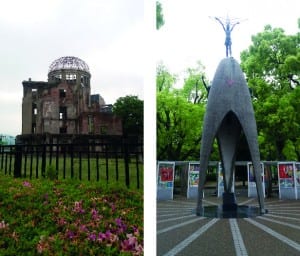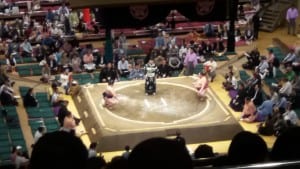Not working in Japan, aka travelling
By Zoe Mildon, on 13 May 2016
As well as working during my fellowship in Japan (see previous blog post), I have been able to travel around much of the country and see a variety of sights.
My first travels outside Sendai were to the Fukushima prefecture to meet with a group of UCL students who were in the country for a cultural exchange to commemorate five years since the Great Tohoku earthquake and tsunami (see recent blog article). I joined them for a weekend, and a lot was packed into two days, including visiting Fukushima Dachii nuclear power plan, a Japanese castle, painting Japanese candles and staying in a ryokan (Japanese style hotel) with an onsen (hot springs).
My second long weekend trip was partly geological and partly touristy. Shinji (my supervisor in Japan) took my husband Peter and I (he had come to visit me while I was in Japan) to Kobe and the area that was damaged during the 1995 Hanshin earthquake. We visited a museum on Awaji Island where the surface
offset from the earthquake has been preserved by pumping glue and preservatives into the soil. They had also dug down to reveal a cross-section of the fault at the surface. To get to Awaji Island we crossed the Akashi Kaikyō bridge which is the longest suspension bridge in the world. The 1995 earthquake actually affected its construction. The fault, which moved with strike-slip motion, passed between two pillars that had been constructed and offset them by ~1m relative to each other, hence they had to be realigned following the earthquake. After this, Shinji took me to one of the oldest seismic observatories in Japan, near Kyoto, which has a collection of seismometers from ~1900 to the present day.
The earliest seismometers took up an entire room, whereas the most modern one was the size of a brick and weighed only 1.5kg. Then our trip became more touristy, Shinji took us to Nara, the first capital of a united Japan in 710 AD. The biggest tourist attraction is the largest Buddha statue in Japan, housed inside the largest wooden building the world. There are also tame deer that wander around the old part of the city and can be fed. Peter and I spent the rest of the weekend in Kyoto and Nagoya (most famous for the Toyota factory) being tourists.
After a couple of weeks of hard work, I took a week off to travel with my husband and a friend visiting from the UK. This was quite unusual for the other people in my office, I think Japanese people don’t usually take such long holidays! We went right off the tourist track, into a small town in the central Japanese Alps, in order to climb a small active-ish volcano. We were probably the only westerners in the town, and we caused a bit of a stir when we went to the local onsen, which was otherwise full of old Japanese people, who spoke no English whatsoever! Before I came to
Japan, many people had told me about seeing the sakura (cherry blossoms) and how special an occasion it is. We were in a city called Kanazawa on what was probably the most spectacular day for viewing the blossoms, warm, blue skies and all the blossoms were out. Sakura really is a fabulous sight, both in the cities and the countryside. Our last stop was Tokyo, where we spent three days. Tokyo is as huge and crazy as I was expecting. Travelling into Tokyo on the Shinkansen (bullet train), for about an hour before you arrive at Tokyo station there are dense buildings almost as far as the eye can see. Much of Tokyo is busy, built up and lots of neon lights, but there are pockets of quieter (and usually older) districts.

Left: The Genbaku Dome in Hiroshima, the bomb exploded about 600m above this building. Everyone inside was killed instantly. Right: Children’s Peace Monument to commemorate all the children who dies as a result of the bomb.
Last week, four friends from university came out for Golden Week (national holidays). We mainly stayed in Kyoto and did a couple of day trips out, including to Hiroshima. The Peace Museum in Hiroshima is an incredibly informative and moving museum, documenting the physical effects of the atomic bomb, from short-term thermal radiation to long-term cancer, as well as the physics behind the bomb and why it was dropped on Hiroshima in particular. We visited a geisha show in a theatre in Kyoto, as well as numerous temples and shrines. The highlight of my week was going to the opening day of the sumo grand tournament in Tokyo. It was not at all like I expected it to be, there was a lot of ritual and ceremony involved, but the fighting only lasts 5-30 seconds!
Travelling around Japan by Shinkansen is incredible for so many reasons. Firstly (and probably most well known) they are incredibly fast, Sendai is about 350km from Tokyo, which is about the distance between London and Newcastle, and the Shinkansen takes only 90 minutes! The trains are also spacious and comfortable, even in standard class. Their only disadvantage is how expensive they are to buy tickets, but in my opinion the speed is worth paying for. At the other end of the spectrum, local lines out of cities are typically very cheap, for example I got a train to a place called Matsushima, just outside Sendai, a 50min train ride which cost 400yen (about £2).
My overall impression so far of Japan is that it is a culture of extremes, between the very old and the very new and technologically advanced. Wherever I have been, people are very friendly and helpful, even through the language barrier. Before I came, I have to admit I didn’t have a burning desire to visit Japan, but having been here, I would thoroughly recommend it as a country to visit.
 Close
Close





